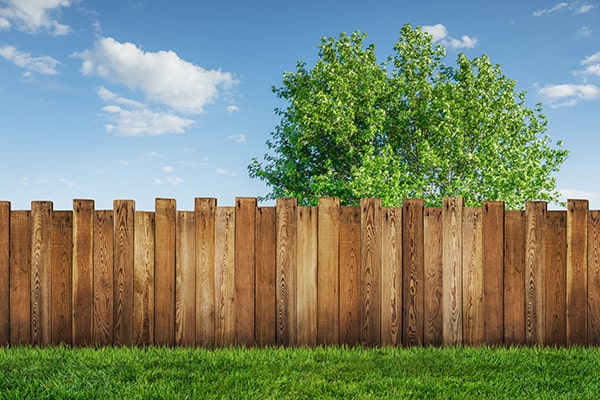
There are three main points to consider when thinking about landscaping fence lines. Any and all plants along a fence line usually involve softening, camouflaging, or playing up the stylistic theme of the hard landscaping. In most cases a wooden fence is a straight-edged hard-scape element, which requires a bit of softening visually. Plants are typically used to make this happen. There are other fences built with different materials that require plants to hide them altogether. The very common chain-link fencing is one of these materials that have no ornamental value, but they are common due to their practical functionality. The third type of situation can be characterised by the traditional white picket fencing. This type of fence evokes a stylistic theme of a cottage garden, whether the material is PVC or the classic wooden type. Traditional cottage garden plants are often grown by homeowners along such a picket fence; giving that feeling of tranquillity from the folksy or rustic setting. When thinking about landscaping fence lines, there is a practical side and an aesthetic side to the plants.
Practical Side to Plant Fence Lines
The practical side of planting involves, in part, the sunlight requirements of plants. Landscaping locations with a southern or western exposure should be in beds grouped with full-sun plants, while landscaping locations with an eastern or northern exposure should be done with shade plants. Another practical consideration for these plants is the water requirements of the groups of plants. Fencing actually creates a sort of microclimate and this microclimate has a direct effect upon the plants. Consider a fencing landscape that has a southern exposure, which is in full sun. This particular environment is sheltered and thus will experience higher temperatures. Some plants cannot handle higher temperatures, while other plants actually thrive in higher temperatures. The plants which may suffer in this environment are those which need breezes to avoid succumbing to fungal disease like powdery mildew. Other plants like tall perennials that may need staking in other locations may benefit from the fence as they grow up fencing instead of a stake.
Other practical considerations for landscaping fence lines may involve things other than the vegetation that is used. The type of fencing that is used is surely a practical consideration. A wooden fence, which requires regular maintenance like periodic painting or staining requires plants to be spaced away from the fence to allow access for the maintenance. On the other hand vinyl fencing does not require this type of regular maintenance and may allow plants to be placed closer in proximity to the fence. This consideration of space must involve thoughts of how large some plants will grow as they mature. Another space consideration involves plant care tasks such as pruning shrubs. While the idea of vine plants festooning throughout a fence may be a good idea when using chain-link fencing, it may not be a good idea when using wood fencing since staining a wooden fence is made impossible by the vine plant material. This problem can be remedied by choosing an annual vine so that the maintenance can be accomplished prior to installing the plant. Morning glory flowers are a good choice in this situation because the annual maintenance to the wooden fence can be done in the spring. Another way to get around the problem of maintaining a wooden fence when using vine plants is to put the vine plants in portable containers. The containers can be attached to the fence allowing the vines to hang down. For maintenance to the fence, the containers can simply be removed and then re-installed upon completion of any maintenance.
Aesthetic Side to Planting Fence Lines
There can be quite a difference in how attractive a fence line appears visually when a bit of consideration is given to how it is going to turn out. This does not mean a particular style has to be chosen, like that of the cottage garden style discussed earlier. It just means that some aesthetic considerations can make a marked difference. For instance, the fencing can be made to look like a seamless part of the entire yard when fence plants are considered in relation to the rest of the landscape. Repetition is a landscape design principle that can create the feeling of unity throughout the entire landscape. The feeling that one plant bed flows into another can be done by repeating, for example, maiden grass from a nearby bed along the fence as well. Plants for fence lines and for the landscape as a whole should be done with all four seasons in mind, not simply for a single season or part of the year. There are a couple of ways to accomplish this task.
- Grow plants such as red twig dogwood in addition to any evergreen shrubs for the winter. Against fencing with ample sunlight the red twig dogwood looks great, especially if the fencing is white.
- Late blooming bushes and long-blooming perennials are great plantings for summer. The bushes may include the rose of Sharon and bluebeard shrubs.
If you wanted to have a look around at some of the styles of fences mentioned in this post then you could start by visiting our traditional fences range. Similarly, if you feel that your landscaping line needs some protection from the wind and natural forces, then you can take a look at our taller fences to see if there is anything that would suit your purpose.
For more information on our higher fences take a look at our video below.




